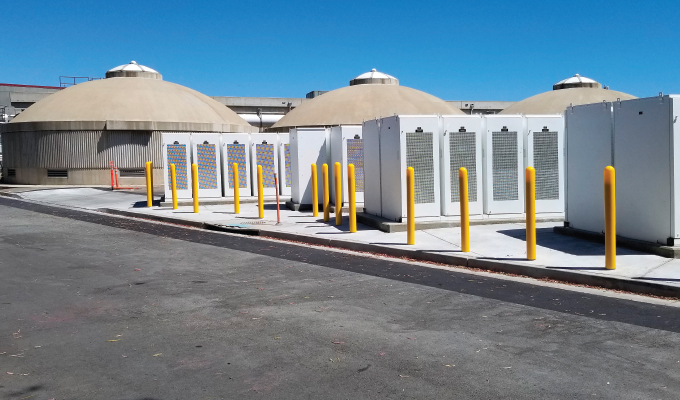Mission-critical facilities realize that batteries provide a trustworthily, Uninterruptible Power Supply (UPS) to augment the grid during outages. However, this option has not always been available, as until relatively recently batteries were not a cost-effective means to hedge against the grid’s instability. Improvements in lithium-ion technology and scalability have transformed storage into a notable option for utilities, burning coal, natural gas, or diesel fuel.
ECONOMIC ALTERNATIVE
Today, batteries are a cost-effective, economic alternative to backup diesel generators, due to technological advancements in management software, coupled with the fact that they require minimal maintenance and are friendlier to the environment.
Although batteries decrease greenhouse gases and don’t need tank loads of diesel fuel—which are difficult to get following a natural disaster—the main reason for selecting them is simple economics—they are cheaper to operate compared to generators.
They are a far superior option compared to peaker plants, which are incredibly expensive for utilities to maintain and operate. Peaker plants also create an enormous amount of greenhouse gases in addition to particulate pollution, often in the heart of urban neighborhoods. In addition, batteries require no spool-up time, as opposed to large peaker plants, as they can start supplying power in seconds when needed. Add to that the ability to recycle them at end of life (as opposed to dealing with the ground contamination common to underground fuel tanks, potential fuel leaks, etc.) and the economics become fairly stark.
BATTERY OPTIONS TODAY
There are multiple viable battery options on the market today, such as NextEra Energy and BYD that utility-grade project developers can consider. Perhaps the most impressive battery options to date come from Tesla. The company has already demonstrated its expertise by powering the world’s largest lithium-ion battery installation in Hornsdale, South Australia, using its Powerpack batteries—although the power is being produced by the wind. In its July 2019 blog, “Introducing Megapack: Utility-Scale Energy Storage,” the company boasts that Hornsdale saved nearly $40 million in its first year and helped to stabilize and balance the region’s unreliable grid. Engineers were all “charged up” by these results and went on to produce the utility-scale Megapack, which will ship from the factory fully assembled and bring a payload of up to 3-megawatt hours (MWhs) of storage and 1.5 MW of inverter capacity.
In late March, Hawaiian Electric announced the development of an 810 MWh installation at its Kahe Generating Station on Oahu, adding to the Megapack’s front-runner status. To put things into perspective, it would have over six times the energy capacity of the Hornsdale project, and would currently be the largest BESS in the world.
SOLAR + BATTERY
While the majority of the initial battery energy storage system (BESS) projects were standalone storage systems, we’re now seeing a great many involving the integration of solar power and battery storage. This pairing has become popular because solar panel prices continue to drop, and there are sophisticated software control systems that add a great deal of flexibility for developing more resilient, smart energy grids.
TOO NEW TO BUDGET
Even though many companies are considering utility-scale battery and solar deployments, the truth is this: developers and contractors are having a difficult time with the budgeting process. Nobody is entirely confident regarding how long installations will take with the new products—they are that new. Tesla boasts that its equipment can be deployed 10 times faster than any other product, but the reality of that remains to be seen.
Companies exploring linked battery and solar installations need to seek help from an experienced engineering and design partner, who can explore all the alternatives well before a project begins:
- Can the baseload be offset by fuel cells or other alternatives?
- Will you be peak-load shaving from solar?
- Will you be using a combination of load shifting and emergency backup from the batteries?
- Is a microgrid an option for some level of grid Independence?
- What is the end user’s real need?
It’s important not to cut corners on the design, installation, or the selected technology. These installations are meant to be a 20-plus year investment, and should be approached as such. There is also a knowledge gap happening with these storage systems. Companies need to realize that the installation, inspection, and commissioning process requires specifically trained individuals, because many in the industry are not yet up-to-speed.
CLOSING THOUGHT
Taking the extra time to find a qualified and trusted provider with extensive knowledge of battery and solar installations is critical. Rubicon Professional Services has installed 44 of these types of projects since 2016—for a total of 122.6 megawatt-hours of storage. In addition, RPS built one of the largest behind-the-meter energy storage systems in the country, leveraging Tesla’s Powerpack, at 4.95 megawatts. It’s the qualified installation professionals working hand-in-hand with industry experts that will ensure these new alternative energy sources are properly brought to life and live up to expectations.
For more information
Abbot Moffat is senior program manager, business development manager for Rubicon Professional Services (www.rubiconps.com), which provides an innovative alternative for constructing or upgrading data centers, telecom sites, and other critical facilities, and providing Engineering, Procurement & Construction (EPC) services for renewable energy, battery storage, and distributed generation projects.
Modern Contractor Solutions, May 2020
Did you enjoy this article?
Subscribe to the FREE Digital Edition of Modern Contractor Solutions magazine.



